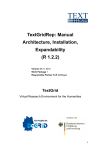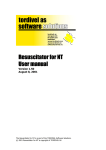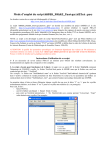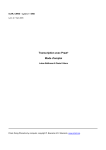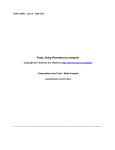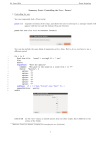Download "User-Manual zur Anbindung von Werkzeugen an die TextGrid
Transcript
TextGrid Manual:
Tool Development
Version - 24.2.2008
Work Package - AP 3
Responsible Partner - SUB, DAASI
TextGrid
modular platform for collaborative text editing a community grid for the humanities
TextGrid Manual: Tool Development
1
Project: TextGrid
Part of D-Grid and the German e-Science Initiative
Funded by the German Federal Ministry of Education and Research (BMBF)
by Agreement 07TG01A-H
Project Duration: February 2006 - May 2009
Document Status: final
Distribution: external
Authors:
Andreas Aschenbrenner, SUB
Stefan Funk, DAASI
Martin Haase, DAASI
Roman Hausner, SUB
Christoph Ludwig, FH Worms
Wolfgang Pempe, Saphor
Ubbo Veentjer, SUB
Thorsten Vitt, TU Darmstadt
TextGrid Manual: Tool Development
2
Table of Contents
1. introduction.............................................................................................................................5
2. an architecture overview.........................................................................................................6
3. service environment................................................................................................................8
4. initialization..........................................................................................................................11
4.1. configuration, Java client library...................................................................................11
4.2 configuration, Web Service-based .................................................................................11
4.3 configuration, in Eclipse ................................................................................................12
4.4. logging, Web Service-based..........................................................................................13
4.5. logging, Java Client library............................................................................................13
4.6. logging, Eclipse-based...................................................................................................14
5. TG-auth*...............................................................................................................................15
5.1. Obtaining Authentication Information...........................................................................15
5.2. interacting with the authorization system - TG-authZ, Web-Service-based..................16
6. TG-search..............................................................................................................................19
6.1. Parameters......................................................................................................................20
6.2. REST interface...............................................................................................................22
6.3. SOAP/WSDL.................................................................................................................22
6.4. Accessing TG-Search, Eclipse-based............................................................................22
7. TG-crud.................................................................................................................................24
7.1. service methods and parameters....................................................................................24
getVersion.........................................................................................................................24
create.................................................................................................................................25
readMetadata.....................................................................................................................25
read....................................................................................................................................25
updateMetadata.................................................................................................................26
update................................................................................................................................26
delete.................................................................................................................................26
7.2. fault messages................................................................................................................26
7.3. usage of the Java TG-crud client stub............................................................................27
getVersion request.............................................................................................................27
read request.......................................................................................................................28
7.4. handling large files - MTOM.........................................................................................29
TextGrid Manual: Tool Development
3
8. TextGridLab’s Object Model................................................................................................30
8.1. three implementation layers...........................................................................................30
8.2. Getting a TextGridObject – From a TextGrid URI........................................................31
8.3. Getting a TextGridObject – From a Metadata blob.......................................................31
8.4. Representing TextGridObjects.......................................................................................31
8.5 Contributing new kinds of documents............................................................................31
Extending the New Object wizard....................................................................................32
TextGrid Manual: Tool Development
4
1. introduction
TextGrid1 strives to be an open ecosystem, where just any e-Humanities initiative can reuse
existing functionality, add and share functionality, or tailor a research environment to specific
needs and scientific processes. This document describes software developers how to achieve
all this.2
TextGrid has rich functionalities to be reused,3 and great efforts are being taken to ensure
interoperability with initiatives around the world to further extend that portfolio. With sharing
your services and application patterns you hence contribute to the global e-Humanities. At the
same time, it is your task to hide the wealth and complexity of the ecosystem from the user,
by building tailored research environments.
For tools, there are fundamentally two entry points to TextGrid: (1) a specialised web service
(e.g. a lemmatiser, a semantic annotator) can be linked into the service network; (2)
applications are built upon the service network and tailored to the needs of its dedicated user
group (TextGrid's primary application environment is an Eclipse Rich Client).
Following the outline of the document, you will first learn about the general concepts and
how to embed your own web services into the TextGrid environment. Each chapter takes you
one step further into TextGrid, with the last chapter describing programming in TextGrid's
Eclipse-based application environment. However, if you primarily mean to build your own
interactive application using TextGrid's grid abstraction in Eclipse, you may choose to start
with the very last chapter jumping to earlier parts of the document as needed.
Accompanying this document is a programming tutorial, which describes in detail both the
service layer as well as the Eclipse environment for TextGrid.4 To achieve this, the tutorial
creates in a number of steps first, a simple web service for extracting names out of published
TextGrid objects, as well as an Eclipse application, which interlinks a TextGrid object, the list
of extracted names, as well as the Wikipedia entries for each of those entries. Please use this
general documentation in tandem with the tutorial for quickly picking up on the TextGrid
development environment.
1
More information about TextGrid can be found at www.textgrid.info
For adding your digital assets into TextGrid (e.g. collections of digitisations and/or TEI-annotated texts), please
refer to the respective TextGrid Manual on www.textgrid.info (to be published January 2009).
3
Existing services are described in the document "TextGrid components" published on the TextGrid website (for
now only in German). Further strengthening of the TextGrid community will include the construction of a
community portal, where anybody can describe their services and application patterns.
4
see the TextGrid documentation at www.textgrid.info for the tutorial
2
2. an architecture overview
The TextGrid architecture is layered, with the lower layers being long-term stable and the
higher layers being as flexible as possible. Entry-points are available on all layers, with
maximum openness on top and increasingly rigid constraints towards the basis. Starting
development at the topmost layer and successively advancing towards more stability in the
infrastructure is recommended.
This architecture approach was built on the following principles:
◦
to provide an open, generic
infrastructure Functionalities are only
constrained where
indispensable; the application
context of a service is not preempted. Thereby, services can
be re-used in different contexts
and re-mixed for efficient
development of novel
applications.
◦
to foster specialized
applications and semantically
deep processing - Specialized
workflows, targeted goals and
Figure 1 - TextGrid architecture scheme
unique contexts demand
formats, metadata, and
interfaces to be freely adapted. TextGrid allows for this. However, there may be different
levels of support and interoperability for specific formats, metadata schemata, or
interfaces. Thus, TextGrid users can embed their specific requirements in TextGrid at
various levels of integration.
◦
to encourage participation - Community participation is crucial to obtain a growing
base of scientific texts, service variety, and ultimately the sustainability of the
infrastructure. Participation in TextGrid is possible on multiple levels, from tentative
usage to active contribution and partnering.
Technologically, these guiding principles are translated into the following conceptual layers.
Being a service-oriented architecture, each layer itself may consist of multiple, distributed
components and may evolve with a changing technological and organisational context.
◦
application environment - virtual research environments tailored to specific user
needs.. The main application environment in the initial project phase is Eclipse-based and
geared towards use in philology. However, other user groups or workflows may call for
other environments.
◦
services - building blocks of specialized functionality. Atomic functionalities such as
tokenization, lemmatizing, or collation are wrapped into individual services to be re-used
by other services or plugged into an application environment. A growing community
contributes to this tool-kit of interoperable services.
◦
middleware and archives - generic utilities for a stable core. The basic building
blocks of the TextGrid infrastructure comply with the interoperability framework for
services, however they offer more generic functionality at increased stability and
scalability.
3. service environment
In order to foster interoperability, integration into the service environment is possible on
several steps. The first step of integration is rather loose, with growing requirements as well
as growing possibilities with each additional step. For example, authentication is necessary
from the third step on. Each initiative can choose how far they advance into the TextGrid
service network.
Each kind of service (rows) implements specific properties (columns). The following
properties are hardly dependent on who hosts a service, and where - anybody, anywhere is
invited to join in:
a.
b.
workflow-enabled
The service can be mashed up with other services in a workflow. The workflow editor
in the TextGridLab may embed the service in a comprehensive batch process.
Basically any programming language and host environment can be used for the
services, yet web service standards form the basis for interoperability.
•
WSDL 2.0, SOAP 1.2 (document-literal style) or REST
•
character encoding: UTF-8
registry-entry
The installation of a service registry is planned for the future. This registry allows the
documentation of services and their interfaces. The more generic a service is designed,
the better for its reuse. For example, a lemmatiser for a specific language should avoid
prescribing a specific XML/TEI schema; rather, it can take any stream of text and
return the text with respective annotations for the lemmatised words, ideally enabled
to parameterize the output markup or at least employ the same tags as other
lemmatisers in the service network do.
c.
•
provide sufficient documentation with your service
•
learn from other services and follow conventions
•
test your service exhaustively, and provide feedback-mechanisms for users to
report bugs
user interface
A graphical user interface is available and it can be embedded (with other services) in
user environments. Initially, the premier user environment is an Eclipse-based client,
though web-based or other clients may follow. Actual user environments may be
tailored to a specific user group (e.g. discipline, project), thus each service/tool may be
embedded in various user environments.
•
d.
e.
5
the user interface (resp. each user interface, e.g. Eclipse-based, web-based, etc.)
embeds nicely into the respective environment and follows its conventions.
Documentation can be found at the respective user interface project. See chapter
for the Eclipse-related documentation.
grid access
The service carries all the necessary information to be allowed into the grid. This
includes information for authentication and logging. TextGrid is Shibboleth-enabled
and will interconnect with the national scientific Shibboleth federation DFN-AAI once
productive. For the time being, users can register at TextGrid directly to be granted
access. Grid access entails the possibilities to join projects, deposit and share (private)
digital objects, and similar activities. In the future, licensing policies may build on
authentication information.
•
the first parameter of the service interface (WSDL) is a String parameter auth to
carry authentication information. When communicating with TextGrid services,
this parameter should be duly filled with suitable data from (1) passing the
authentication information from one service to the next5, (2) request credentials
from TG-auth* directly, or (3) employ e.g. the authentication module in Eclipse to
mediate the credentials (incl. the necessary user interaction).6
•
the second parameter of the service interface (WSDL) is a String parameter log
with logging information: string containing the URL of the Logging-Service,
SessionID for the Logging-Service, Loglevel. The Loglevel can be Loglevel: 0 Disabled 1 - Error 2 - Warning 3 - Info 4 - Debug.7
upkeep
With the measures a-d, the service implements all requirements for interoperability
with other services in the e-Humanities service network. This includes TextGrid
services, as well as services from Interedition8 and other sources. Beyond technical
Unfortunately, mechanisms for the WSDL Header to pass on service meta-data like authentication and logging
are not sufficiently implemented in all Frameworks. Our experiments with e.g. Python were not satisfying.
6
Refer to chapter .
7
Refer to chapter .
8
Interedition. http://interedition.huygensinstituut.nl/
measures, however, the availability and maintenance of the service needs to be
ensured.
•
trusted partners with good documentation of their services and a stable
organisational environment are awarded this label.
4. initialization
For initializing the TextGrid environment, there are two steps to take: (a) connect to the
TextGrid configuration service, and (b) initialize the logging service. The configuration
service provides endpoints of the infrastructure services (e.g. where to fetch files from, where
to send logging information). There is a separate configuration service for each environment:
the productive environment and the test instances.
4.1. configuration, Java client library
For use in Java client code (for Eclipse plug-ins, see the subsequent section), we provide a
convenience library to access the config service. The jar file is available at
https://develop.sub.uni-goettingen.de/repos/textgrid/trunk/middleware/confclient/
For a query to the config service, you only need to instantiate the ConfservClient class and
call one of the methods getValue() and getAll(). The class ConfservClientConstants provides
String constants that can be used as arguments in the calls to getValue() and as keys into the
resulting HashMap of getAll().
import info.textgrid.middleware.confclient.ConfservClient;
import info.textgrid.middleware.confclient.ConfservClientConstants;
...
ConfservClient csc = new ConfservClient
("http://textgridlab.org/axis2/services/confserv");
String tmp = csc.getValue(ConfservClientConstants.LOG_SERVICE);
After above code snippet, tmp may hold the value
"http://textgridlab.org/axis2/services/textlog". We will describe the log service in
more detail below.
4.2 configuration, Web Service-based
First of all, you need to establish, where all the components of the TextGrid API are. For this,
you only need a single point of contact, the configuration service (of the productive
environment) at
https://textgridlab.org/axis2/services/confserv
This service is your gate to all the infrastructural environment information you may need, and
hence the only hard-coded endpoint in your code.9 The service is available as SOAP-based
(SOAP 1.1/2.0) and RESTful. You can either retrieve all available endpoints
9
Besides the convenience factor, we may in the future establish multiple entry-points and dynamically allocate
those, which are close to the very user or those with less load. The configuration service will then allocate the
most suitable service.
(getAllValues), or request one specific endpoint (getValue). The most important available
endpoints are defined by the following constant strings:
◦
logservice ... for logging; see chapter
◦
tgauth ... authentication - get a session ID; see chapter
◦
tgsearch ... metadata and XML content search, for retrieval; see chapter
◦
tgcrud ... ingest and retrieve digital objects; see chapter
In addition to the service endpoints, the service also tells you the current TextGrid object
metadata namespace and the location of the corresponding schema file:
◦
ns ... namespace of TextGrid data
http://textgrid.info/namespaces/metadata/core/<date of version>
◦
schema ... the XML Schema for the TextGrid core encoding
www.textgrid.info/schemas/textgrid-metadata_<date of version>.xsd
For those services that run over a particularly long period, you may want to establish a
mechanism for re-retrieving the environment setting. We recommend a pattern using
org.apache.axis2.engine.ServiceLifeCycle - for closer instructions please refer to an Axis2
manual of your convenience.
4.3 configuration, in Eclipse
We provide a Eclipse Plug-in that integrates a client for the config server into Eclipse and
Eclipse-based Rich Clients. The singleton info.textgrid.lab.conf.client.ConfClient
in the Plug-In available at
https://develop.sub.unigoettingen.de/repos/textgrid/trunk/lab/info.textgrid.lab.conf/
offers the basic functions to connect to the configuration service and access the current
settings there. Download and enable this plug-in in your client.
...
import info.textgrid.lab.conf.client.ConfClient;
import info.textgrid.middleware.confclient.ConfservClientConstants;
...
try {
ConfClient confClient = ConfClient.getInstance();
String value =
confClient.getValue(ConfservClientConstants.LOG_SERVICE, false);
} catch (RemoteException e) {
// do something
}
The plug-in adds an entry in your preferences dialog that allows you to specify the endpoint
of the config service.
4.4. logging, Web Service-based
TextGrid caters for a dedicated logging mechanism, which enables chained logging across
multiple services no matter where those services are hosted and what their system
environment is like. A logging server receives and stores logging messages from just
anywhere via a Web Service interface. A logging session ID then identifies a chain of services
in a specific workflow. The session ID is passed along with other information as the second
WSDL parameter from service to service.
In the following we describe a typical logging session:
First, a client starts a new logging session with the logging service's initialize operation. This
operation that takes no input data returns a unique logging ID that clients need to provide in
all subsequent requests.
Clients then start putting information into the log by calling the "log" operation. The log
operation's input message consists of the log ID that was previously issued by the initialize
operation, a string identifying the origin of the log message, and the log message proper.
"Client" can either be the party that originally called the initialize operation or any other
service to which it passed the logging ID. By convention, services that are aware of the
TextGrid logging mechanism get this information (dubbed "loginfo") as one of their input
parameters in form of a space separated list of strings comprised of the logging service's
endpoint, the logging ID, and a log level indicator that indicated which events the service is
supposed to log.
The log can be read by the getLogFragment operation. This operation expects the logging ID
and a log index (of the XML Schema type int) and responds with a list of log strings that
includes all log messages starting at the given index up to the most recent log entry. Each log
string consists of a timestamp, the origin and the actual message.
Finally, the client is supposed to call the endSession operation that deletes the complete log
and releases all associated resources allocated by the logging services. If a client fails to call
endSession, then the resources are freed automatically 24 hours after the last read or write
access to the log identified by the logging ID.
4.5. logging, Java Client library
We provide a convenience library for logging in Java-based environments. This library is
intended for use in web services that receive the loginfo (containing logging ID, etc - see
above) from their caller. Consequently, it does not provide methods to read log entries. The
library can be retrieved from
https://develop.sub.unigoettingen.de/repos/textgrid/trunk/middleware/textgridlogger/TextgridLog
ger.jar
The following sample code presumes that the loginfo is stored in a String variable of the same
name.
import info.textgrid.middleware.textgridlogger.*;
...
TextgridLogger logger = new TextgridLogger(loginfo);
logger.log("log message", "this.servicename", loglevel);
...
where
String loginfo - you'll get the loginfo string passed on from the caller
(the TextGridLab or another service) as a second parameter
int loglevel - 0/Disabled 1/Error 2/Warning 3/Info 4/Debug
4.6. logging, Eclipse-based
The Eclipse Plug-in info.textgrid.lab.log provides mechanisms for logging and for
viewing previously logged information. On initialization, it connects to the log service and
initializes a new log session. The thus generated loginfo can be passed on to child services for
logging.
...
import info.textgrid.middleware.textgridlogger.*;
import info.textgrid.lab.log.logsession;
...
logsession log = logsession.getInstance();
String loginfo = log.getLoginfo();
...
where
String loginfo - to be passed on as the second web service parameter;
( <URL-logging-server> + " " + <session-ID> + " " + <loglevel> )
Apart from this API, the plug-in also offers a user interface to set the right log level and view
log messages. The corresponding view has the ID "info.textgrid.lab.log.views.logview" and
can be found in Window/Show View/Other ... with the entry "Log Category - Log View".
5. TG-auth*
TG-auth* consists of two parts. With “N” replacing the asterisk, it enables for authentication
of users in the TextGrid environment. With “Z”, it serves as a powerful authorisation engine
properly defining who may access resources.
As for authentication, an infrastructure based on the Internet2 software Shibboleth is used. For
authorization, we use a role-based access control solution called openRBAC where
permissions are stored in an LDAP database. The whole process of authenticating and
authorizing access to a specific resource is as follows:
the TextGridLab-internal browser (or an external one) is pointed to an internet
resource (in the following, the WebAuth resource) protected by a Shibboleth Service
Provider (SP).
before allowing access to the WebAuth resource, the SP redirects the browser to a list
where the users can select their home institution (or Identity Provider, IdP). After
selection the browser is redirected to the login page of the IdP. On successful login the
IdP redirects back to the SP and attributes are sent, too. We use the attributes
eduPersonPrincipalName (ePPN, form: ), givenName and sn (surname)
now the WebAuth resource processes the request which includes:
adding the user by their ePPN to the RBAC database (if not present yet)
creating a SessionID and activating all roles the user has in RBAC
delivering a result page to the browser with SessionID and ePPN both humanvisible and machine-readable in the headers
finally, the SessionID can be used by services in the lab to represent the user. The
ePPN is used currently for display purposes.
authorization now amounts to check if
a given resource can be treated with
a given operation
given the roles activated for the presented SessionID.
There are several functions dedicated to this purpose both in the TextGrid-specific
layer built for openRBAC and in its core functions.
Besides these functions for processing authorization requests and returning access
decisions, both the openRBAC core and the TextGrid-specific layer contain numerous
functions for managing roles, permissions, resources, users and sessions.
5.1. Obtaining Authentication Information
In the TextGridLab, the Singleton class info.textgrid.lab.authn.RBACSession manages all
issues relevant to authentication. Thus when a service needs to know the SessionID of the
current user, the following code can be used:
import info.textgrid.lab.authn.RBACSession;
...
String sessionID = RBACSession.getInstance().getSID(false);
String ePPN = RBACSession.getInstance().getEPPN();
...
Calling getSID(false) returns the SessionID currently active. This could also be the null
string in the case the user had not authenticated before. Contrary to that, getSID(true) first
checks this and, if empty, opens a modal (i.e. GUI-blocking) dialogue that lets the user
authenticate. This dialogue basically holds the browser which points to the WebAuth resource
located at the URL the Config Server returns for the key ConfservClientConstants.AUTHZ. It
is also possible to override the value getSID() returns by setting the environment variable
TEXTGRIDLAB_SID before starting the Lab.
5.2. interacting with the authorization system - TG-authZ, WebService-based
The RBAC functions are defined at the WSDL at
https://textgridlab.org/tgauth/rbacSoap/wsdl/tgextra.wsdl. The actual parameters and return
values can be read from the WSDL, whereas we shortly describe the meaning of each
function in its respective category here. The RBAC endpoint of the currently active
TextGridLab instance can be obtained from the instance's configuration server, using key
ConfservClientConstants.TG_AUTH.
users and
sessions
roles
authenticate
Internal function used by applications to identify
themselves (via shared secret between RBAC and
WebAuth).
userExists
Checks whether this ePPN exists in RBAC.
getSid
Returns some random SessionID suitable for RBAC.
createProject
Creates a project. Projects are roles with various sub-roles,
i.e Leader, Administrator, ... Creates default roles with
default permissions which can be adapted afterwards.
tgAddActiveRole
Activates a role for a session.
tgDropActiveRole
De-activates a role.
tgAssignedRoles
Returns the roles the requesting user has, in any project.
Can be called for another user by project leaders, then
roles will be limited to that project.
tgAssignedProjects
Returns projectIDs of all projects the user has any role in.
getAllProjects
Returns all project IDs stored in this RBAC instance.
addMember
Project leaders can assign users into specific roles.
deleteMember
Delete a role from a user.
getMembers
All members in the project, caller must be member.
getProjectDescriptio Name and description of project(s) identified by ID(s).
n
deactivateProject
Deactivated projects cannot be modified or read anymore
(except published resources). However, information is
preserved so that the project can be re-activated by manual
modification of database.
getLeader
Returns Project Leader/s (i.e. who have delegate right on
the respective project resource).
resources10 (registerResource)
Registers a resource in the database. Assigns standard
permissions to roles in project which can be adapted
afterwards. User needs create right on project resource.
Only for use by TG-crud.
(unregisterResource) Removes resource from database. User needs delete right
on resource. Only for use by TG-crud.
rights
getOwner
Returns ePPN of owner that was set in registerResource.
tgGrantPermission
Enables given operation for given role on given resource.
Resource may be normal (file) or project. Users need
delegate right on resource or project.
tgRevokePermission Disables this permission, see tgGrantPermission for
limitations.
10
getRights
Returns permissions for given resource or projectID. Can
be used by project leaders to check permissions for another
project member.
publish
Sets the isPublic flag to TRUE. The resource will then be
world-readable. This is irreversible.
The resource operations, especially registerResource and unRegisterResource, are not API and must not be
used by clients. Clients (including services) should call TG-crud.create and TG-crud.delete instead, see
section Fehler: Referenz nicht gefunden.
access
control
isPublic
Returns status of isPublic flag.
getObjects
Returns URIs of all resources in project. Caller must have
some role in the project.
tgCheckAccess
Returns access decision for given operation on given
resource for session.
6. TG-search
TG-search provides several interfaces for text retrieval and metadata search. To understand
what TG-search does, it might be useful to have a look on the data lifecycle in TextGrid:
Once created (or modified), a dataset and its metadata are stored in the grid. This is done by
TG-crud (method “write” or “update” – see below). But that’s not all what happens with the
data. For the purpose of project-specific as well as cross-project search the metadata and
structure data is also stored in an XML database11. In order to enable cross-project search,
every dataset of structure data is also stored in an extra instance which is transformed to a
certain uniform, TEI-based markup, the so called Baseline Encoding12.This transformation is
performed by a specialized TG-crud module, the Adaptor Manager13.
TG-search per default enables access to these two collections:
/db/metadata
/db/structure/baseline
Project-specific encoded data is stored in
/db/structure/original
and is accessible via individual XQueries or a specialized instance of TG-search.
The following description covers only the combined search over the two first mentioned
collections, which is internally performed by parameter-generated XQueries. Also, it
describes exclusively the Web Service layer (SOAP and REST). The Research-tool in the
TextGridLab (described in the user documentation) builds upon the web services as described
here.
11
Currently deployed: eXist 3.0 (http://exist-db.org)
See the documentation to the TextGrid Baseline Encoding; available on www.textgrid.de
13
See also Report 3.2, "Textannotationen und Adaptoren"; available (in German) on www.textgrid.de
12
6.1. Parameters
Name
Description
Examples (GET)
sid
the session ID provided by TG-auth* (see chapter Fehler: Referenz nicht
gefunden, AuthN)
log
the log string (see chapter )
q
Query string for (full) text search.
q=hier
sd
structure data, names of elements (separated by “|”) constraining the text search
sd=p|head
md
metadata; Retrieval of metadata, matching datasets and/or constraining a text
search to datasets complying to the specified metadata. Key-value pairs are
connected with a colon, if there are more than one, they have to be separated
using “|”. You can filter for certain elements by using “$” instead of a string
value. Searching for attribute values is also possible: agent@role:goe@author
finds <agent role=”author”>Goethe</agent>
md=title:wörterbuch|agent:campe|uri:$
mdns
metadata namespace; overrides the default metadata namespace. Useful for
retrieval of legacy data.
mdns=http://textgrid.info/namespaces/metadat
a/core/2008-03-13
xpath
Search for text and element nodes in
xpath=//div/head
• baseline-encoded textual/structure data
md=agent@role:campe@author
md=agent:goe schill grass|agent:$
xpath=//agent[@role=’author’]&opt=metadata:1
• core metadata
resp. in the particular namespaces.
xquery
Searching via XQuery, only makes sense using POST
See below (POST)
dbparams
Mirrors the parameters to handle the server-side result-sequences of the RESTinterface of eXist (http://www.exist-db.org/devguide_rest.html#N1030B):
dbparams=start:1|max:10|session:1
start: index of first item in the result sequence to be
returned
max: maximum number of items to be returned
session: eXist session id as returned by previous request
opt
Additional features for
• Text query (parameter q): key-word-in-context-mode:
opt=kwic:1
• Metadata query (parameter md): auto-completion of result string:
opt=ac:1
• XPath query (parameter xpath): search in metadata:
opt=metadata:1
rel
< the relational database has a variable query mechanism at this point >
Currently supported combinations of parameters14
q, (md, mdns?)?, sd?, dbparams?, (opt=kwic:1)?
md, mdns?, dbparams?, (opt=ac:1)?
xpath, dbparams?, (opt=metadata:1, mdns?)?
xquery
14
in DTD style – optional elements marked with "?", sid and log not considered
q=am&sd=head&opt=kwic:1
md=agent@role:goe@author&opt=ac:1
xpath=//uri&opt=metadata:1
6.2. REST interface
The most effective way to approach TG-search from outside the TextGridLab is to use the
REST interface via POST. The query parameters have to be modelled as XML fragment, e.g.
<tg:meta xmlns:tg="http://meta.textgrid.de">
<tg:sid>RBAC_SESSION_ID</tg:sid>
<tg:log>LOG_STRING</tg:log>
<tg:md>agent:goe|agent:$|type:text|type:$|uri:$</tg:md>
<tg:q>ich</tg:q>
<tg:opt>kwic:1</tg:opt>
<tg:dbparams>start:1|max:100</tg:dbparams>
</tg:meta>
The service endpoint is
http://textgridlab.org/axis2/services/Metadata/
For an example REST client implementation based on Axis2-1.4 see
https://develop.sub.unigoettingen.de/repos/textgrid/trunk/lab/info.textgrid.lab.search
6.3. SOAP/WSDL
See
http://textgridlab.org/axis2/services/Metadata?wsdl
6.4. Accessing TG-Search, Eclipse-based
The class info.textgrid.lab.search.TextGridQuery represents a Query objects to be handed
over to the search service. It basically has the methods for setting the parameters mentioned
above. The results of the search will be held in the instance of class
info.textgrid.lab.search.ResultHolder. This class will be given the raw answer of the Service
and will parse it to extract the information contained therein (method fetchDeferredChildren).
This will contain SingleSearchResult objects, which themselves can contain TextGridObjects
together with the information how many search hits there were, and optionally the context
(KWIC) where the search term was found.
Here are the methods that will set the parameters for a TextGridQuery:
setQueryText(String text)
setQueryMetadata(Map<String, String> queryFields)
setQueryBaselineElements(String[] bes) // term must occur in these BEs
setKwic(boolean kwic)
// return context of search term
setFullMetadata(boolean fmd) // return just URI or full MD?
setWantOriginal(boolean wantOriginal) // search in original encoding?
setPortion(String maxHits, String start, String session)
Possible keys for the Metadata Map are agent, type, title, project.
The following code shows how a simple list of all TextGridObjects of type „workflow“ can
be retrieved. These objects will be displayed in a jface TableViewer (corresponding
LabelProvider omitted).
import info.textgrid.lab.search.ResultHolder;
import info.textgrid.lab.search.TextGridQuery;
import info.textgrid.lab.ui.core.UpdatingDeferredListContentProvider;
[...]
viewer = new TableViewer(parent, SWT.NONE);
UpdatingDeferredListContentProvider contentProvider
= new UpdatingDeferredListContentProvider(
TextGridObject.class);
viewer.setContentProvider(contentProvider);
[...]
ResultHolder resultHolder = new ResultHolder();
TextGridQuery query = new TextGridQuery(resultHolder);
HashMap<String, String> queryFields = new HashMap<String,
String>();
queryFields.put("type", "workflow");
query.setQueryMetadata(queryFields);
viewer.setInput(resultHolder);
7. TG-crud
The TextGrid crud service is a web service to create, read, update and delete TextGrid
resources, which can be TEI encoded documents as well as image files, e.g. TIFF or JPEG
images. It is the interface to storing information to the replicated grid environment and the
TextGrid databases – the central XML database (eXist) as well as the RDF-based relation
database (Sesame), and furthermore the role based access control system (RBAC) using the
TG-auth service. The crud service also checks access permissions and ensures that the
TextGrid repository stay consistent.
It also uses the Adaptor Manager to convert TEI documents into the TextGrid baseline
encoding using XSLT scripts, which also are stored in the XML database for efficient
structural search. The Adaptor Manager also is capable of extracting relation information
from the TEI files and the generated baseline eocnded files (as contained links to other
TextGrid resources and XML schema references) and put them into the RDF database.
The service's input and output parameters to use the crud service and interface with the
TextGrid repository are described in the service's WSDL file
(https://textgridlab.org/axis2/services/TGCrudService?wsdl). The service can be
accessed via SOAP, either by simply using the provided Java service stubs15 (created by
Axis2) or by setting up other SOAP-based web service clients if Java is not available or
another web service framework shall be used. Furthermore a REST-based interface is
provided (which also comes with Axis2), but was not heavily tested.
7.1. service methods and parameters
The TG-crud web service provides the following methods to access the TextGrid repository.
Its input and output parameters will be described below except the two sessionId and
logParameter, which already were mentioned in TG-auth* 16 and Logging17 and must be used
here. The schema of the TextGrid metadata is available at
http://www.textgrid.info/schemas/textgrid-metadata_2008-07-24.xsd.18 This
schema is used in the crud service's WSDL file to create the TextGrid metadata object via
Axis Data Binding.
getVersion
Input parameters: sessionId (String), logParameter (String)
Output parameters: tgCrudVersion (String)
Faults: none
15
The current Java TG-crud client stubs are provided here for quick TG-crud access:
https://develop.sub.uni-goettingen.de/repos/textgrid/trunk/middleware/tgcrud/
16
cf. chapter 5. TG-auth*
17
cf. chapter 4.4. logging, Web Service-based
18
For a more detailed description of the TextGrid metadata please have a look at the TextGrid metadata and
baseline encoding paper at www.textgrid.de
Description: getVersion returns the version name, number and date of the currently
used crud service as a string, e.g. „v1.0 beta rc3 "energize" 2008-11-14“. Please use
this version string to identify the TG-crud version in case of error or bug reports.
create
Input parameters: sessionId (String), logParameter (String), tgObjectMetadata
(textgridMetadataType), data (base64Binary)
Output parameters: tgObjectMetadata (textgridMetadataType)
Faults: authFault, ioFault, metadataParseFault
Description: From the given TextGrid object – the metadata and data file – a new
TextGrid resource will be created: (1) The data and metadata file will be stored to the
grid, (2) relation information will be extracted from the metadata file as well as, if
possible, from the data file, and stored to the RDF database, (3) the metadata file will
be stored to the XML database and also the data file, if possible (using the Adaptor
Manager) and finally (4) the resource will be registered to the RBAC using the TGauth* service. In the returned TextGrid Object Metadata some middleware metadata
will be provided, such as the URI of the object, its size, the creation date, and some
more. The URI is created from the given metadata and some project and date
information19. This URI is a unique TextGrid identifier and identifies the created
resource unambiguously in the TextGrid repository and is hence used for retrieving or
updating the resource again later.
readMetadata
Input parameters:sessionId (String), logParameter (String), uri (anyURI)
Output parameters: tgObjectMetadata (textgridMetadataType)
Faults: authFault, ioFault, metadataParseFault, objectNotFoundFault
Description: The metadata file of the TextGrid object with the given URI will be
loaded from the grid. Some metadata will be fetched from the RBAC via TG-auth*
and be filled in the metadata file, e.g. the object's owner and its permissions.
read
Input parameters: sessionId (String), logParameter (String), uri (anyURI)
Output parameters: tgObjectMetadata (textgridMetadataType), data (base64Binary)
Faults: authFault, ioFault, metadataParseFault, objectNotFoundFault
Description: This method retrieves the metadata file as in readMetadata, and
additional the data file will be delivered, too.
19
For a more detailed description of the TextGrid metadata please have a look at the TextGrid metadata and
baseline encoding paper at www.textgrid.de
updateMetadata
Input parameters: sessionId (String), logParameter (String), uri (anyURI),
tgObjectMetadata (textgridMetadataType)
Output parameters: tgObjectMetadata (textgridMetadataType)
Faults:authFault, ioFault, updateConflictFault, metadataParseFault,
objectNotFoundFault
Description: Updating only the metadata of a TextGrid object is possible with this
method by just giving the new metadata file and the URI. The URI in the given
metadta file (tgObjectMetadata.administrative.middleware.uri) will not be
used, but the lastModifiedDate
(tgObjectMetadata.administrative.middleware.lastModifiedDate) is
nesecarry to check the metadata's actuality. A change of adaptors
(tgObjectMetadata.relational.hasAdaptor) is not permitted yet.
update
Input parameters: sessionId (String), logParameter (String)
Output parameters: tgObjectMetadata (textgridMetadataType)
Faults:authFault, ioFault, updateConflictFault, metadataParseFault,
objectNotFoundFault
Description: Within this method the data file is updated, too. For the metadata all the
rules mentioned above do apply. An update of adaptors in the metadata file is
permitted in this method.
delete
Input parameters: sessionId (String), logParameter (String), uri (anyURI)
Output parameters: deleted (boolean)
Faults: authFault, ioFault, objectNotFoundFault, relationsExistFault
Description: This URI's document will be deleted from the TextGrid repository. A
deletion is only possible yet, if you (1) have the role of a administrator, (2) the object
is not published yet, and (3) the object is not involved in any chain of relations within
the RDF database.
7.2. fault messages
In the following table all TG-crud fault mesages will be described. Every fault message has
two parameters, which describe the error and its possible cause. The parameter faultMessage
is about what went wrong in crud, what the service could not do, e.g. „Failure storing data to
XML database“, „Unable to read metadata file from URI 'textgrid:...'“ or „Metadata update
denied“. The parameter cause explains what caused the error in crud, which can be messages
from exceptions that occured in underlying services, e.g. in TG-auth* while checking access
permissions, in JavaGAT while accessing grid resources or in the several used database
clients (XML and RDF databases).
authFault
An authFault occurs, if a certain action is not permitted using
the given session ID, e.g. a project member tries to delete a
TextGrid resource, which is not allowed at the moment or
someone tries to update an already published resource, that
only permits readonly access.
ioFault
A more general fault, that always occurs, if there are any
problems with grid or database access.
objectNotFoundFault
A requested resource is not found, e.g. the URI is not
existing.
metadataParseFault
The TextGrid metadata could not be parsed correctly. This
fault can occur if invalid metadata files are sent to the TGcrud or some XSLT adaptor scripts fail to parse the given TEI
data file.
relationsExistFault
If a TextGrid object shall be deleted from the repository and
there are any relations in the RDF database, the deletion is not
permitted yet.
updateConflictFault
An updateConflictFault occurs, if the lastModifiedDates or
the hasAdaptor relation content given in the metadata differs
from the values stored to the grid. That means another person
probably already updated the resource. The actual data and
metadata must then be read again and be merged, e.g. using
the TextGrid collation tool. After that an update can be done.
7.3. usage of the Java TG-crud client stub
getVersion request
At first, of course, you need to import the client stub JAR file as following:
import
info.textgrid.namespaces.middleware.tgcrud.services.tgcrudservice.
TGCrudServiceStub;
You also must import some of the Axis2 classes, e.g.
import org.apache.axis2.AxisFault;
import org.apache.axis2.databinding.types.URI;
The next step is to create a instance of the stub – the reference server_url points to the
endpoint you already got from the config service (cf. chapter 4.1. configuration, Java client
library):
TGCrudServiceStub stub = new TGCrudServiceStub(server_url);
As first service call we ask the service for its version. Therefore we do create instances of the
following objects: GetVersion, GetVersionType and GetVersionResponseType.
GetVersion getVersionRequest = new GetVersion();
GetVersionType getVersionType = new GetVersionType();
Then fill the GetVersionType with the authentication and logging parameters
(rbacSessionId and logParam) provided by the config service and assign the
GetVersionType to the getVersionRequest:
getVersionType.setSessionId(rbacSessionId);
getVersionType.setLogParameter(logParam);
getVersionRequest.setGetVersion(getVersionType);
Now we can create and fill our getVersionResponse Parameter, that will provide us with the
services response parameters, the serbice call happens in the stub.getVersion() method:
GetVersionResponse getVersionResponse =
stub.getVersion(getVersionRequest);
Finally get the version string returned from the TG-crud service and do whatever you like
with it:
String tgCrudVersion =
getVersionResponse.getGetVersionResponse().getTgCrudVersion()
read request
To receive a complete TextGrid object – a metadata and a data file – from the TG-crud
service, do as in the getVersion request and use the appropriate parameters, take the uri of
the object you mean to retrieve (cf. e.g. the chapter on TG-search):
Read readRequest = new Read();
ReadType readType = new ReadType();
readType.setSessionId(rbacSessionId);
readType.setLogParameter(logParam);
readType.setUri(uri);
readRequest.setRead(readType);
ReadResponse readResponse = stub.read(readRequest);
And finally retrieve the service's response:
MiddlewareMetadataType metadata =
readResponse.getReadResponse().getTgObjectMetadata();
DataHandler data = readResponse.getReadResponse().getData();
7.4. handling large files - MTOM
MTOM (SOAP Message Transmission Optimization Mechanism) allows for the transfer of
binary attachments of arbitrary size via SOAP, as well as increased performance through
caching. More information about MTOM can be found on the Axis2 homepage20, or the
specification by the W3C21
For (a) enabling MTOM in the client, use
<code>
stub._getServiceClient().getOptions().setProperty(Constants.Configuratio
n.ENABLE_MTOM,
Constants.VALUE_TRUE);
</code>
(b) enabling caching at client side
<code>
stub._getServiceClient().getOptions().setProperty(Constants.Configuratio
n.CACHE_ATTACHMENTS,
Constants.VALUE_TRUE);
stub._getServiceClient().getOptions().setProperty(Constants.Configuratio
n.ATTACHMENT_TEMP_DIR,
"/textgrid/tmp/");
stub._getServiceClient().getOptions().setProperty(Constants.Configuratio
n.FILE_SIZE_THRESHOLD,
"4096");
</code>
20
21
http://ws.apache.org/axis2/1_4_1/mtom-guide.html
http://www.w3.org/TR/soap12-mtom/
8. TextGridLab’s Object Model
TG-crud offers a rather different interface for saving information than Eclipse: Eclipse’s
storage system is based on a workspace containing named projects containing named files and
folders, rather oriented on traditional file systems. TG-crud, however, maintains a set of
objects described by a set of metadata (like authors, title etc.). Both can use URIs to identify
files.
The plugins info.textgrid.lab.core.model and info.textgrid.lab.core.efs.TG-crud try to bridge
the gap between both systems and to offer a convenient way for TextGridLab plugins to
access both TextGridRep's objects and metadata.
8.1. three implementation layers
We use three implementation layers to manage our objects:
◦
The model layer represents TextGridRep's objects using their metadata, in
TextGridObject's. This layer is completely implemented by TextGrid, and it is the
layer clients like object browsers or metadata editors usually talk with and which
commands and menu entries on TextGrid objects are usually contributed to.
◦
The resource layer containing IFiles, IProjects and other IResources is the layer
(content) editors usually see. It is the standard way of interacting with files in Eclipse,
and it is completely implemented by Eclipse.
◦
The EFS layer contains the backend that performs the actual reading and writing. It is
implemented by TextGrid extending an interface defined by Eclipse, and clients
usually don't interact directly with this interface
Conversion between the layers works by using the adaptor pattern as provided by Eclipse.
I.e., if you have a TextGridObject and need an IFile,
TextGridObject textGridObject;
/* ... fill textGridObject ... */
IFile file = (IFile) textGridObject.getAdapter(IFile.class);
if (file != null)
/* do something with file */
or vice versa
IFile file;
/* ... fill file ... */
TextGridObject textGridObject = (TextGridObject)
file.getAdaptor(TextGridObject.class);
To read or write data from or to a TextGridObject, you can then use IFile’s methods
setContents() and getContents(), which take or give you input streams for the object’s
contents.
8.2. Getting a TextGridObject – From a TextGrid URI
URI uri;
/* get the object's URI somehow into uri */
TextGridObject object = TextGridObject.getInstance(uri, true);
This creates a new TextGridObject from a TextGrid URI, calling TG-crud#readMetadata if
neccessary. If you set the last argument to false, the call to readMetadata may be delayed.
8.3. Getting a TextGridObject – From a Metadata blob
You need to pass in the metadata as an XML tree fragment hanging from an OMElement
(that's AXIOMs element representation). The OMElement should contain the
tgMetadataObject.
OMElement element;
boolean complete;
// if false, element contains only fragmentary
metadata
/* get some metadata into element */
TextGridObject object = TextGridObject.getInstance(element, complete);
If you create a TextGridObject from an XML fragment, there will be no immediate network
access. This is especially useful if you create a lot of TextGridObjects at once (think search)
and do not want a web service call for every single one. With the last argument (complete),
you determine whether the metadata fragment you pass in is complete, i.e. it contains all the
metadata TextGrid knows about for this TextGridRep object. If you specify false here and
access a field not present in the metadata fragment at a later point in time, the object is finally
completed by a call to TG-crud's readMetadata operation.
8.4. Representing TextGridObjects
If your plugin somehow represents / contains a bunch of TextGrid objects (e.g. search results
or object browser), your objects (the stuff you put in your StructuredSelections and/or that
your ContentProvider provides) must adapt22 to TextGridObjects (and they should adapt to
IFile, as well; once they have a TextGridObject tgo they do so by forwarding the adaption
request to TextGridObject, i.e. return tgo.getAdaptor(IFile.class)).
Either your objects are PlatformObjects or IAdaptables and you provide an adaptor factory, or
you simply put the TextGridObjects themselves in your selection/viewer.
8.5 Contributing new kinds of documents
When contributing a new tool, you may need to specify a new content type, as well. In our
metadata record, the content type’s identifier belongs in the field middleware/client/format. In
TextGridLab, you can see content type support e. g. in the new and import dialog, but it is
22
See, e.g., Wayne Beaton (2008): Adapters. http://www.eclipse.org/articles/article.php?file=ArticleAdapters/index.html for an introduction to the adapter pattern in Eclipse. Also have a look at the class
info.textgrid.lab.core.swtutils.AdapterUtils and its JavaDocs.
also used to determine the default editor for an object you open from the navigator or the
search results. From a developer’s point of view, there are methods in TextGridObject to
retrieve an object’s content type, and there is the class TGContentType with static methods to
list the available content types.
To contribute a new content type to the TextGridLab, go to the Extensions tab in your plug-in
manifest and add an extension to the info.textgrid.lab.core.model.contentTypes extension
point. As an example, this is the extension that contributes XML support, in its XML form:
<extension
point="info.textgrid.lab.core.model.contentTypes">
<contentType
additionalContentTypePattern="xml/.*"
eclipseContentType="org.eclipse.core.runtime.xml"
extension="xml"
image="icons/XML.gif"
internal="false"
name="XML Document"
typeID="text/xml">
</contentType>
</extension>
The most important part is the type ID, which contributes the content that goes to the
administrative/client/format field in the TextGrid metadata record. We also connect an
Eclipse content type (providing the association with existing editors), a file extension for local
links and copies to the file, a human-readable (and localizable) description and an icon for
objects of this type. The detailed documentation for the extension point can be found in its
extension point description, which is available inside Eclipse.
Extending the New Object wizard
Lab users create new objects using the New Object wizard. On the first page, users select the
content type of the object. By default, the wizard will optionally allow the user to enter
descriptive metadata on the second page and, when the user clicks Finish, create a new,
empty, unsaved object with the given metadata and open the default editor for the new object.
You can customize this behaviour by contributing to the extension point
info.textgrid.lab.ui.core.newObjectContributor. Two customization options are available:
•
you can implement metadata preparation and override the action for the wizard’s
Finish button by associating an INewObjectPreparator implementation using the
preparator attribute, and
•
you can add custom wizard pages using wizardPage subelements.
For example, the XML editor contributes additional wizard pages to select a schema and a
root element for new XML files. It generates an XML skeleton and sets it as the initial
contents for the editor (using TextGridObject’s setInitialContents() method) and it opens the
XML editor and switches to the XML perspective when you press the Finish button.
For more and up-to-date details on both the TextGridLab’s object model and these extension
mechanisms, please see the respective class and package javadocs.
































